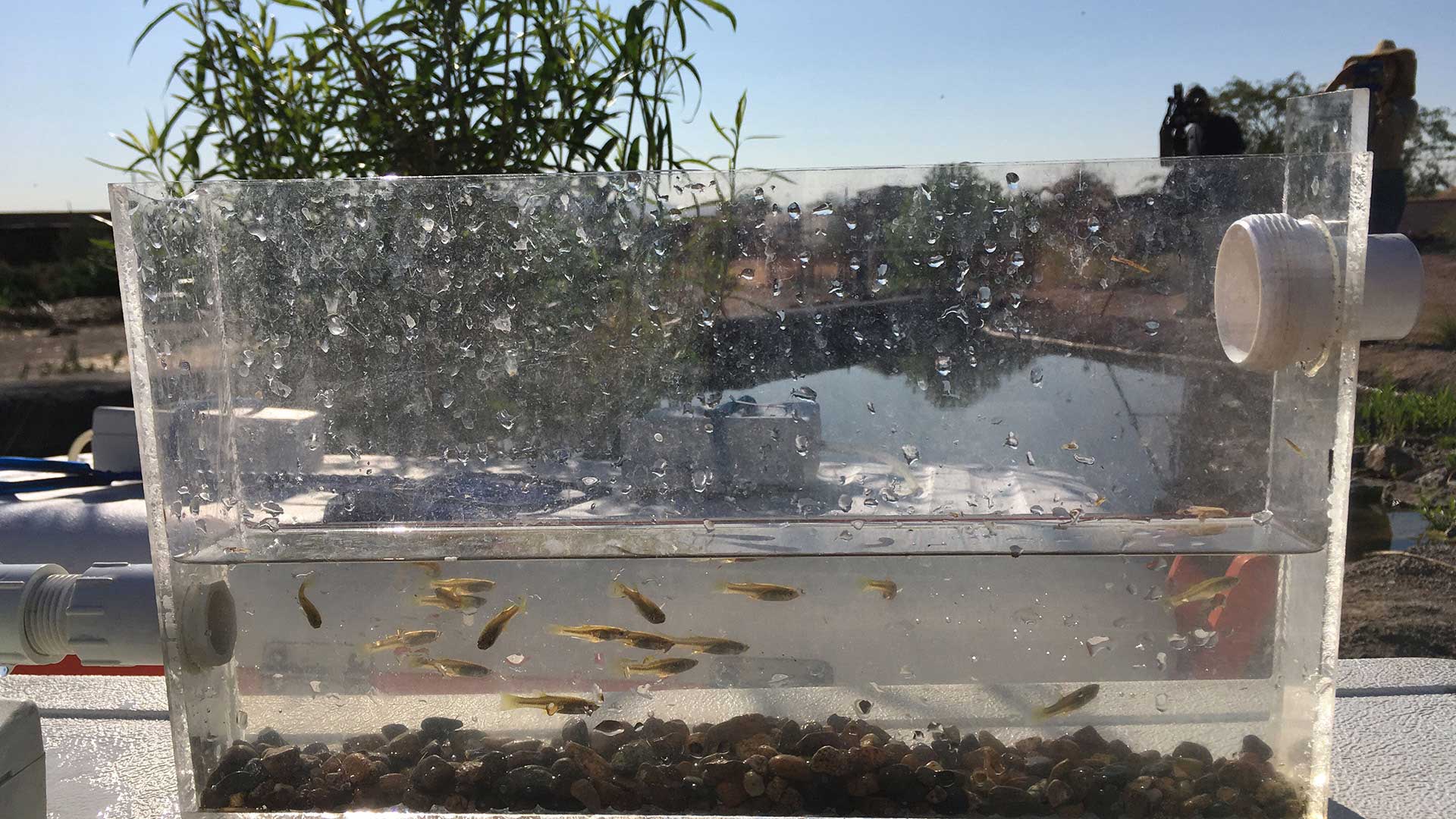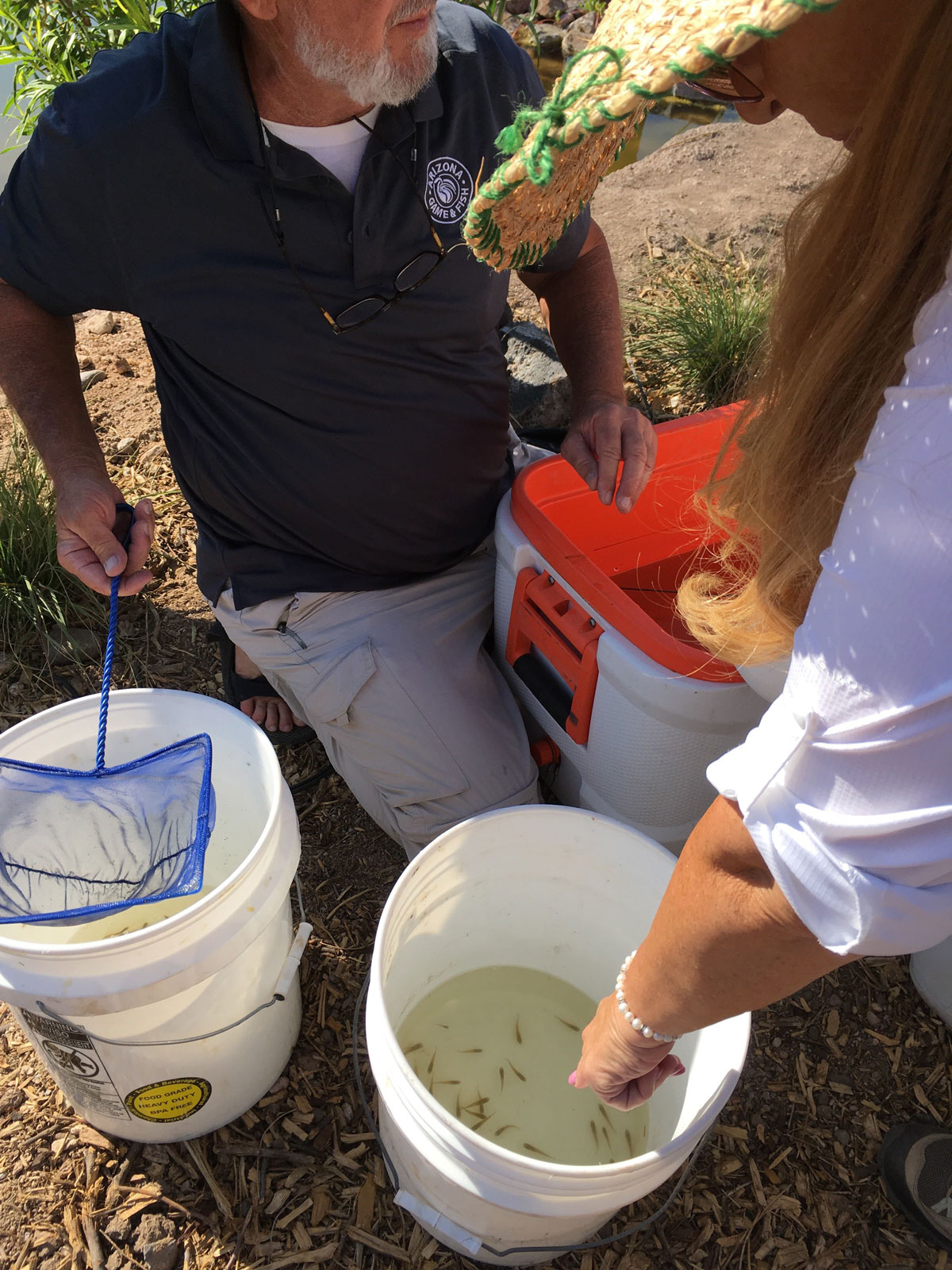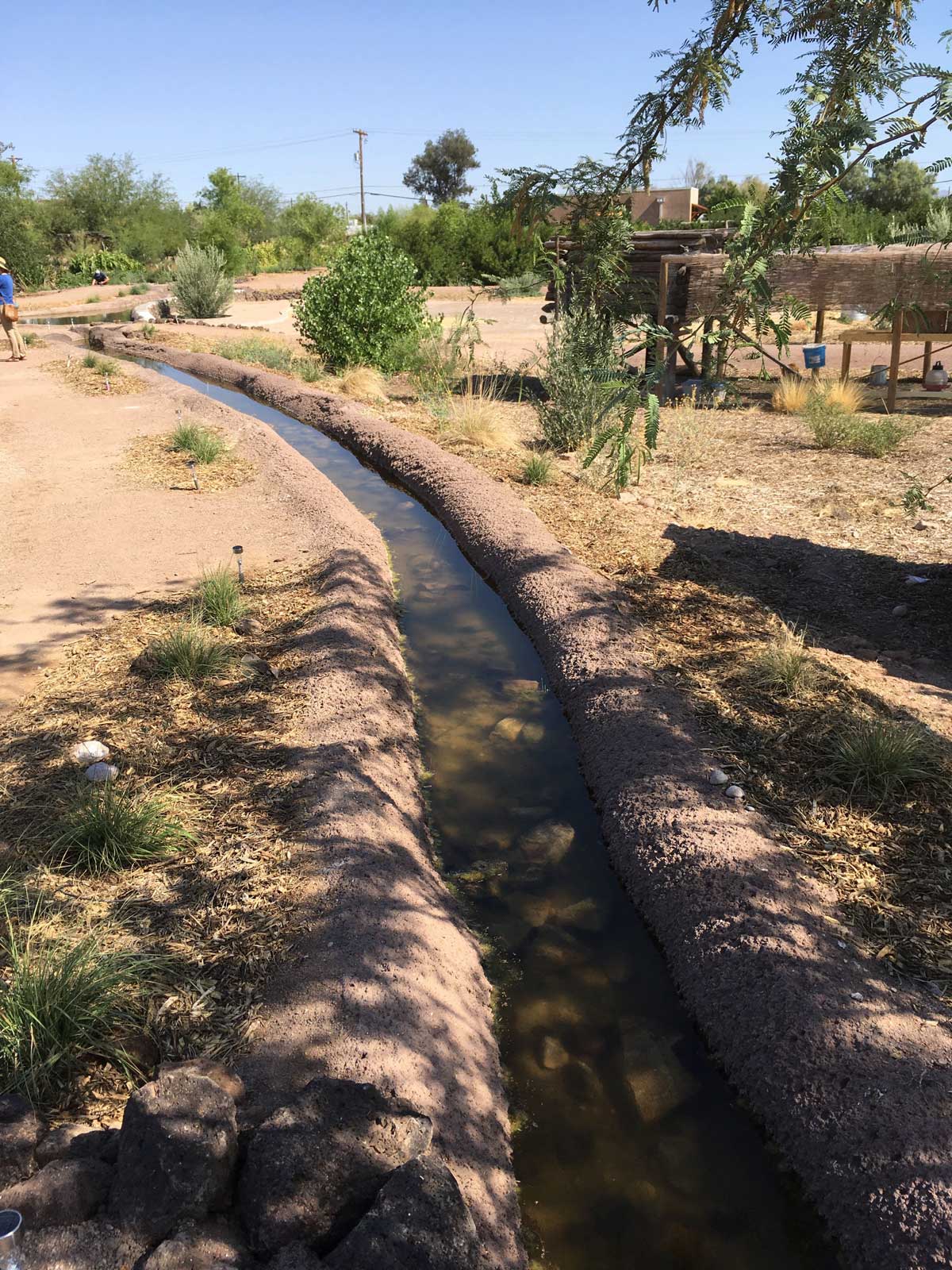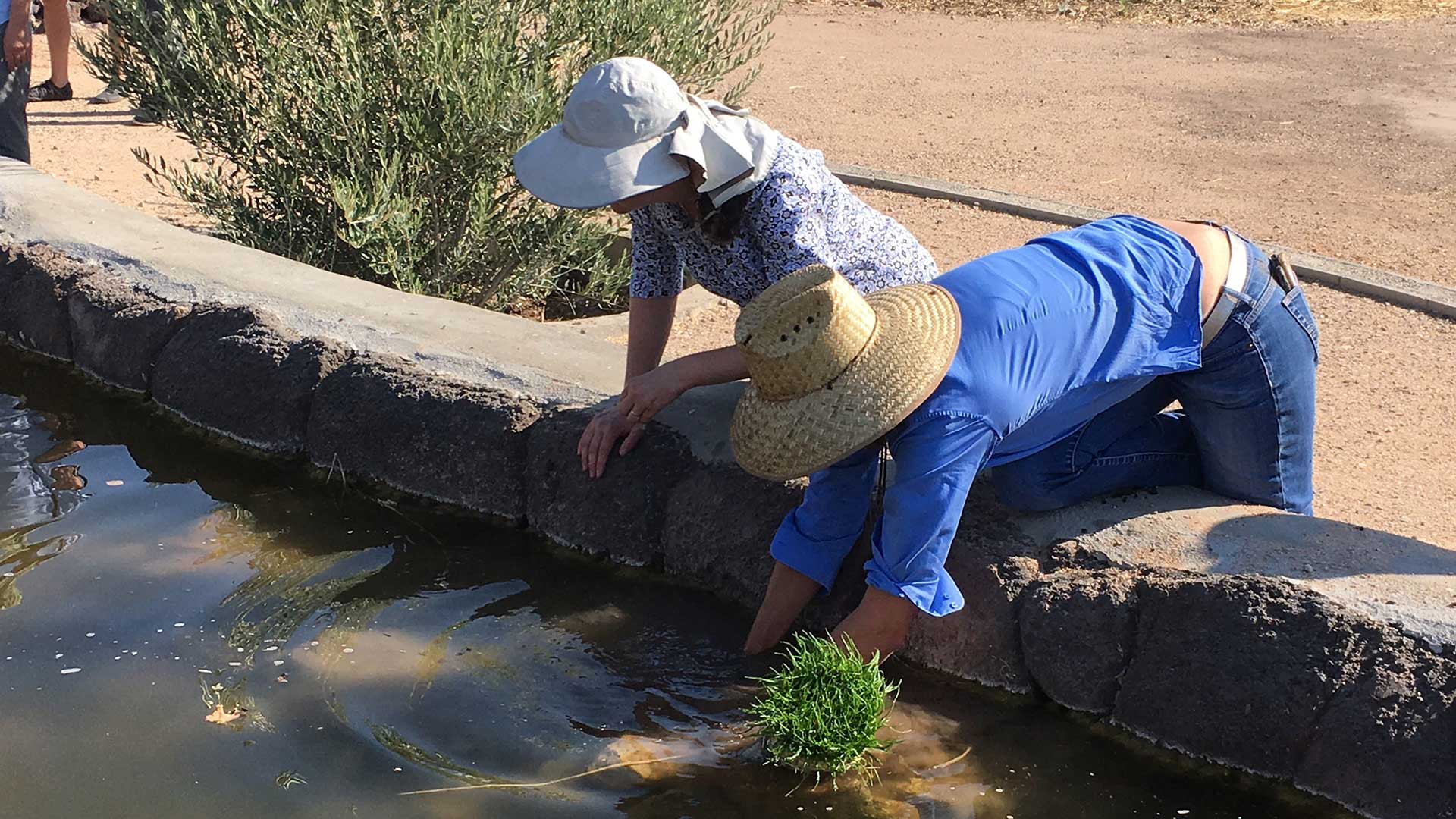 Gila topminnows wait to be introduced to new habitat in the acequia at Mission Garden.
Gila topminnows wait to be introduced to new habitat in the acequia at Mission Garden.
A small, but excited, crowd gathered early Thursday morning to welcome the Gila topminnow into Mission Garden — the re-creation of the Spanish Colonial walled garden that sits between I-10 and "A" Mountain.
Megan Lopez gave an opening blessing.
“Bless everything that walks through here, everyone, the winged, the four-legged, the two-legged, the water creatures, the plants …” she requested.
Katya Peterson, Mission Garden’s co-chair, led people in transferring the small brown fish into the water ditch, or acequia.
Using white 5-gallon buckets, members of the Friends of Tucson’s Birthplace, Pima County, and state and federal wildlife agencies released about 500 of the fish into the narrow irrigation channels that run between desert-adapted fruit trees and vegetables. These fish only measure 1 or 2 inches long, but are known to be a hardy species.
 VIEW LARGER Gila topminnows getting transferred to the Mission Garden acequia.
VIEW LARGER Gila topminnows getting transferred to the Mission Garden acequia. While the acequia isn’t used for irrigation in the garden today, Peterson said it’s a valuable cultural teaching tool that pays homage to the ancient Hohokam waterways that lie underneath the garden.
“These waterways were life: They were life to the fish that we've just put in, but also to the plants people were able to grow right here for over 4,000 years,” Peterson said.
Dennis Caldwell designed the acequia feature at the Mission Garden.
“An acequia is a water system that's used to deliver water through agricultural areas, primarily,” he said. “This is built in the same footprint as the acequia that was originally here, when they did the archaeology, they could find evidence here of an acequia running this route.”
He said the goal was to emulate the historic dirt ditches used thousands of years ago.
“They would clean it out with shovel when plants grew in there to keep water moving through. If you wanted to release water into one of these low-lying fields, you’d use shovel to dig away part of the side of it and let the water run out.” He used a special kind of cement matched to the soil color to create the waterway. Caldwell said he’s pleased the acequia can double as habitat for the topminnow.
“Whenever there's water in the desert, that's a conservation opportunity for these species,” he said.
The Gila topminnow is a fish native to the Gila River basin and a couple rivers in northern Mexico, according to Doug Duncan, a biologist with the U.S. Fish and Wildlife Service who’s been involved in the fish’s conservation. Duncan said it in the past the Gila topminnow was exceptionally common in the Santa Cruz River Basin. But due to habitat loss, there are only about 14 natural populations left today, mostly within a 50-mile radius of Tucson.
 VIEW LARGER Mission Garden is a recreation of a Spanish Colonial walled garden.
VIEW LARGER Mission Garden is a recreation of a Spanish Colonial walled garden. “Because the Gila topminnow is endangered, several of the things we try to do to help recover and conserve the species is to put them into new habitats, so there's more populations, they're redundant, they're protected,” Duncan said.
That includes putting them into captive habitat like the Mission Garden. The Fish and Wildlife Service is also working on reintroduction efforts in Pinal County. Pima County has also been involved in efforts to recover the species. Julia Fonseca, the county’s environmental planning manager, said she recently read a prophetic report from a biologist who visited Tucson in 1905.
“And his prediction was that native fish were going away, in part because of the introduction of livestock, the pollution of streams by mining, the introduction of non-native species — I mean he pretty much nailed it, he nailed all the things that were contributing in 1905 to the demise of these species,” Fonseca said.
 VIEW LARGER The acequia at Mission Garden is a recreation of traditional water irrigation canals.
VIEW LARGER The acequia at Mission Garden is a recreation of traditional water irrigation canals. Fonseca said one of the last times the Gila topminnow was seen in Tucson was in 1943, in a west-side irrigation ditch.
“At that time they were irrigating from the river, and the river flows were declining, and they were starting to use groundwater, so the topminnow persisted in irrigation canals, much like this feature today. And that was the last of the topminnow in our region,” she said.
After a reintroduction effort in the Santa Catalina Mountains, the fish returned to a lower stretch of the Santa Cruz River in 2017, which is fed by recycled water from the county wastewater treatment plant. Fonseca said the minnow’s return to a large river system is significant.
“Even though it’s effluent-dependent now, that may be the most drought-proof habitat that we have in Southern Arizona,” she said.
Two years ago, Pima County started a program to encourage homeowners to put the fish in backyard pools and ponds to help with mosquito control. While the fish are effective, only a handful of people have participated so far.
But like other project partners, Fonseca says the reintroduction at Mission Garden is about more than just another piece of habitat. In May, an endangered native plant species, the Huachuca water umbel, was introduced into the acequia.
 VIEW LARGER People reintroducing the native Huachuca water umbel plant into the acequia.
VIEW LARGER People reintroducing the native Huachuca water umbel plant into the acequia. “For people in Tucson I think it's part of the heritage. I mean we're at the base of 'A' Mountain. We're next to the Santa Cruz river. We've got the Mission Garden, which is really to represent all the cultures that have come to Tucson and thrived along the Santa Cruz River, so of course the Gila topminnow and endangered Huachuca water umbel, they really belong here,” Fonseca said.
And it won't stop here. The county is working with state and federal wildlife agencies to evaluate other reintroduction sites for the future.

By submitting your comments, you hereby give AZPM the right to post your comments and potentially use them in any other form of media operated by this institution.